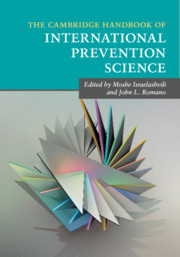29 results
Design and initial results of a programme for routine standardised longitudinal follow-up after congenital heart surgery
-
- Journal:
- Cardiology in the Young / Volume 26 / Issue 8 / December 2016
- Published online by Cambridge University Press:
- 02 February 2017, pp. 1590-1596
-
- Article
- Export citation
Methodology
- from Part I - The Essence of Prevention Science
-
- Book:
- The Cambridge Handbook of International Prevention Science
- Published online:
- 21 January 2017
- Print publication:
- 19 December 2016, pp 133-205
-
- Chapter
- Export citation
Expansion
- from Part I - The Essence of Prevention Science
-
- Book:
- The Cambridge Handbook of International Prevention Science
- Published online:
- 21 January 2017
- Print publication:
- 19 December 2016, pp 456-456
-
- Chapter
- Export citation
The Future of Prevention Science
- from Part II - The Globalization of Prevention Science
-
- Book:
- The Cambridge Handbook of International Prevention Science
- Published online:
- 21 January 2017
- Print publication:
- 19 December 2016, pp 1020-1020
-
- Chapter
- Export citation

The Cambridge Handbook of International Prevention Science
-
- Published online:
- 21 January 2017
- Print publication:
- 19 December 2016
Africa & the Middle East
- from Part II - The Globalization of Prevention Science
-
- Book:
- The Cambridge Handbook of International Prevention Science
- Published online:
- 21 January 2017
- Print publication:
- 19 December 2016, pp 957-1019
-
- Chapter
- Export citation
Appendix 1 - Self-Rating Internet Addiction Scale for Adolescents
- from 23 - South Korea’s Efforts to Prevent Internet Addiction
-
- Book:
- The Cambridge Handbook of International Prevention Science
- Published online:
- 21 January 2017
- Print publication:
- 19 December 2016, pp 570-570
-
- Chapter
- Export citation
The Nature of Prevention Science
-
- Book:
- The Cambridge Handbook of International Prevention Science
- Published online:
- 21 January 2017
- Print publication:
- 19 December 2016, pp 1-18
-
- Chapter
- Export citation
Appendix 2 - Self-Rating Smart Phone Addiction Scale for Adolescents
- from 23 - South Korea’s Efforts to Prevent Internet Addiction
-
- Book:
- The Cambridge Handbook of International Prevention Science
- Published online:
- 21 January 2017
- Print publication:
- 19 December 2016, pp 571-573
-
- Chapter
- Export citation
43 - Prevention Science
- from The Future of Prevention Science
-
-
- Book:
- The Cambridge Handbook of International Prevention Science
- Published online:
- 21 January 2017
- Print publication:
- 19 December 2016, pp 1021-1036
-
- Chapter
- Export citation
Figures
-
- Book:
- The Cambridge Handbook of International Prevention Science
- Published online:
- 21 January 2017
- Print publication:
- 19 December 2016, pp xii-xiii
-
- Chapter
- Export citation
Asia & Australia
- from Part II - The Globalization of Prevention Science
-
- Book:
- The Cambridge Handbook of International Prevention Science
- Published online:
- 21 January 2017
- Print publication:
- 19 December 2016, pp 550-700
-
- Chapter
- Export citation
Acknowledgments
-
- Book:
- The Cambridge Handbook of International Prevention Science
- Published online:
- 21 January 2017
- Print publication:
- 19 December 2016, pp xxiii-xxiv
-
- Chapter
- Export citation
Dedication
-
- Book:
- The Cambridge Handbook of International Prevention Science
- Published online:
- 21 January 2017
- Print publication:
- 19 December 2016, pp v-vi
-
- Chapter
- Export citation
Part II - The Globalization of Prevention Science
-
- Book:
- The Cambridge Handbook of International Prevention Science
- Published online:
- 21 January 2017
- Print publication:
- 19 December 2016, pp 549-1036
-
- Chapter
- Export citation
Copyright page
-
- Book:
- The Cambridge Handbook of International Prevention Science
- Published online:
- 21 January 2017
- Print publication:
- 19 December 2016, pp iv-iv
-
- Chapter
- Export citation
North, Central, & South America
- from Part II - The Globalization of Prevention Science
-
- Book:
- The Cambridge Handbook of International Prevention Science
- Published online:
- 21 January 2017
- Print publication:
- 19 December 2016, pp 701-798
-
- Chapter
- Export citation
1 - The Emergence of Prevention Science
- from The Nature of Prevention Science
-
-
- Book:
- The Cambridge Handbook of International Prevention Science
- Published online:
- 21 January 2017
- Print publication:
- 19 December 2016, pp 2-18
-
- Chapter
- Export citation
Implementation
- from Part I - The Essence of Prevention Science
-
- Book:
- The Cambridge Handbook of International Prevention Science
- Published online:
- 21 January 2017
- Print publication:
- 19 December 2016, pp 206-455
-
- Chapter
- Export citation
Foreword
-
- Book:
- The Cambridge Handbook of International Prevention Science
- Published online:
- 21 January 2017
- Print publication:
- 19 December 2016, pp xxi-xxii
-
- Chapter
- Export citation



